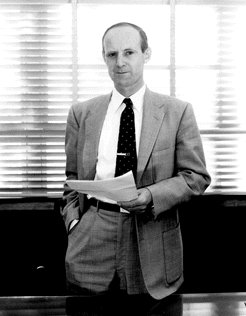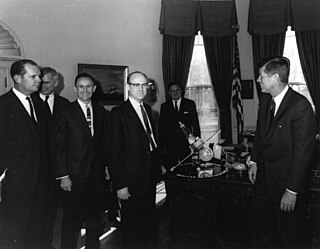
Jet Propulsion Laboratory (JPL) is a federally funded research and development center in La Cañada Flintridge, California, United States. Founded in 1936 by Caltech researchers, the laboratory is now owned and sponsored by the National Aeronautics and Space Administration (NASA) and administered and managed by the California Institute of Technology.

Peter C. Theisinger is the director of the Engineering and Science Directorate at the Jet Propulsion Laboratory in Pasadena, California and was the project manager of NASA's Mars Exploration Rover Mission and later project manager for the 2011 Mars Science Laboratory mission.

William Hayward Pickering was a New Zealand-born aerospace engineer who headed Pasadena, California's Jet Propulsion Laboratory (JPL) for 22 years, retiring in 1976. He was a senior NASA luminary and pioneered the exploration of space. Pickering was also a founding member of the United States National Academy of Engineering.

Gary Arnold Flandro is an American aerospace engineer who is currently the professor for the Boling Chair of Excellence in Space Propulsion (Emeritus) at the University of Tennessee Space Institute. He is also the Vice President and Chief Engineer for Gloyer-Taylor Laboratories (GTL).

Seasat was the first Earth-orbiting satellite designed for remote sensing of the Earth's oceans and had on board one of the first spaceborne synthetic-aperture radar (SAR). The mission was designed to demonstrate the feasibility of global satellite monitoring of oceanographic phenomena and to help determine the requirements for an operational ocean remote sensing satellite system. Specific objectives were to collect data on sea-surface winds, sea-surface temperatures, wave heights, internal waves, atmospheric water, sea ice features and ocean topography. Seasat was managed by NASA's Jet Propulsion Laboratory and was launched on 27 June 1978 into a nearly circular 800 km (500 mi) orbit with an inclination of 108°. Seasat operated until 10 October 1978 (UTC), when a massive short circuit in the Agena-D bus electrical system ended the mission.

Charles Elachi is a Lebanese-American professor (emeritus) of electrical engineering and planetary science at the California Institute of Technology (Caltech). From 2001 to 2016 he was the 8th director of the Jet Propulsion Laboratory and vice president of Caltech.
Kenneth R. Castleman is a retired NASA engineer who now lives in League City, Texas. He holds B.S, M.S. and Ph.D. degrees in electrical engineering from The University of Texas at Austin. He was a Senior Scientist at NASA's Jet Propulsion Laboratory from 1970 through 1985. During that time he headed the Automated Light Microscope project, which paved the way for landing an intelligent microscope on Mars, and he was inducted into the National Space Foundation's Space Technology Hall of Fame. He also served on the faculty at Caltech and on the research staff at USC and at UCLA.

Albert Roach Hibbs was an American mathematician and physicist affiliated with the Jet Propulsion Laboratory (JPL). He was known as "The Voice of JPL" due to his gift for explaining advanced science in simple terms. He helped establish JPL's Space Science Division in 1960 and later served as its first chief. He was the systems designer for Explorer 1, the USA's first satellite, and helped establish the framework for exploration of the Solar System through the 1960s. Hibbs qualified as an astronaut in 1967 and was slated to be a crew member of Apollo 25, but he ultimately did not go to the Moon due to the Apollo program ending after the Apollo 17 mission in 1972.

Eberhardt Rechtin was an American systems engineer and respected authority in aerospace systems and systems architecture.

"Astrobiology of Icy Worlds". astrobiology.nasa.gov. December 2014. Archived from the original on 2024-05-16. Retrieved 2024-05-16.

Raymond L. Heacock was an American engineer who spent his career at NASA's Jet Propulsion Laboratory where he worked on the Ranger program in the 1960s and on the Voyager program in the 1970s and 1980s. A Caltech engineering graduate, he was the winner of the James Watt International Medal for 1979.

Edward Carroll Stone is an American space scientist, professor of physics at the California Institute of Technology, and former director of the NASA Jet Propulsion Laboratory (JPL).

The Jet Propulsion Laboratory Science Division investigates physical and chemical processes on the Earth, in the Solar System, and throughout the universe. Explorations of space and terrestrial processes lead to understanding of the universe. Methods for accomplishing scientific work pertaining to the nature of the Earth, the Solar System, the galaxy, etc., are addressed in the JPL Science Division. Techniques in both physical and life sciences are utilized.

Robert J. "Bob" Parks was an American aerospace engineer and pioneer in the space program where he was intricately involved and/or directed for some of the most historic and important U.S. unmanned space missions. Over a 40-year tenure at the Jet Propulsion Laboratory (JPL/NASA), located in Pasadena, California, Parks’ impact was essential to helping the United States lead the world in space exploration. He served as Guidance Engineer for Explorer 1, the first successfully launched satellite by the United States. He directed the initial flyby missions to the Moon, the first soft landing on the Moon, Earth's first successful mission to another planet and initial missions to Mars, Saturn, Jupiter and Uranus.
Ashitey Trebi-Ollennu, is a Ghanaian robotics engineer at the National Aeronautics and Space Administration (NASA) and the chief engineer and technical group leader for the mobility and manipulation group at the Jet Propulsion Laboratory He has been associated with various NASA Mars missions, notably the Mars Rover and InSight projects.

Psyche is a NASA Discovery Program space mission launched on October 13, 2023 to explore the origin of planetary cores by orbiting and studying the metallic asteroid 16 Psyche beginning in 2029. NASA's Jet Propulsion Laboratory (JPL) manages the project.

Susan G. Finley, a native Californian, has been an employee of NASA's Jet Propulsion Laboratory (JPL) since January 1958, making her the longest-serving woman in NASA. Two days before Explorer 1 was launched, Finley began her career with the laboratory as a human computer, calculating rocket launch trajectories by hand. She now serves as a subsystem engineer for NASA's Deep Space Network (DSN). At JPL, she has participated in the exploration of the Moon, the Sun, all the planets, and other bodies in the Solar System.

Michael M. Watkins is an American engineer, scientist, and a Professor of Aerospace and Geophysics at the California Institute of Technology (Caltech). He previously served as the 9th director of NASA's Jet Propulsion Laboratory in Pasadena, California, and as a vice president of Caltech, which staffs and manages JPL for NASA. His directorial position was effective from July 1, 2016 to August 20, 2021.

Powtawche N. Valerino is an American mechanical engineer at the NASA Jet Propulsion Laboratory. She worked as a navigation engineer for the Cassini mission.

John R. Casani is an American engineer. He worked for the National Aeronautics and Space Administration (NASA) at the Jet Propulsion Laboratory, where he managed the Voyager, Galileo, Cassini and Prometheus projects.
















